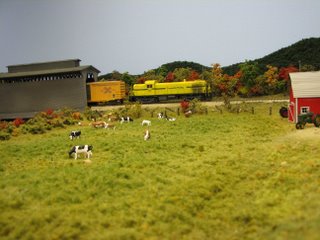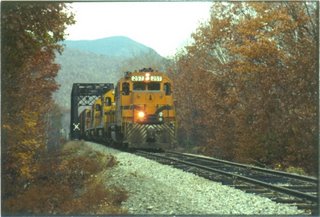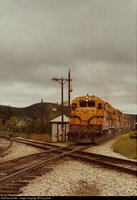(Note: I wrote this in October 2006, but realized I never posted it!)
Well, we're at the end of October and model railroading season is strarting to pick up here on the Northeast Kingdom layout. I've been somewhat busy with other things, but I have a few projects readyto start and some things coming up to get things going.
First up, I have an electrical project just finished up. I'm certainly no electronics expert, but I can solder and run wires pretty well. Back in July at the National Train show I stopped by the booth for Logic Rail Technologies <http://home.houston.rr.com/lrt/>. They had a neat display of a train going through a grade crossing with the flashers going on and off automatically. If you've seen the pictures from my earlier posts, you know I completed a road that crosses the mainline and siding on the Lamoille Valley at East Hardwick, VT. I talked about installing the unit and was convinced it was something I could handle. I picked up their Grade Crossing Pro package along with a bell ringer circuit and speaker.
I had planned to use the Details West Grade Crossing model, but I was unable to get it working with the LEDs supplied. Soldering them and getting them into the castings was frustrating and I ended up with some LEDs that did not work and did not disguise the wires easily. Oh well, back to the drawing board. I went through the Walthers catalog and decided on using the Tomar crossing flashers.
Well, to make this long story a little shorter, I got the flashers and the circuits installed with no real problems. Because I added extra sensors to activate the flashers from the passing and siding tracks, I have a pretty good amount of wires under the layout. But using terminal strips helps keep things under control. I added the bell circuit and speaker and hooked up the power supply. Everything worked! I did have to adjust the sensitivity on the photocells to get the on/off timing to work well. I also found that it helps to have a light source over the cells to avoid accidental tripping of the cuircuit when someone leans close to the layout. I actually already had this covered by havnig a set of three spotlights installed in this area because it seemed a bit dimmer than other areas. This answered my question of whether I needed that light!
I'll post a little video of the grade crossing flashers in action soon, but for now here is a photo:

It's nice to have a project like this completed as it adds sound and animation to the layout, something that is fun for me and for visitors. Speaking of which, I have my layout open on the annual November layout tour that occurs each year throughout the Philadelphia area. So I'll have a few weeks to get a few more things done before the visitors arrive.
Well, we're at the end of October and model railroading season is strarting to pick up here on the Northeast Kingdom layout. I've been somewhat busy with other things, but I have a few projects readyto start and some things coming up to get things going.
First up, I have an electrical project just finished up. I'm certainly no electronics expert, but I can solder and run wires pretty well. Back in July at the National Train show I stopped by the booth for Logic Rail Technologies <http://home.houston.rr.com/lrt/>. They had a neat display of a train going through a grade crossing with the flashers going on and off automatically. If you've seen the pictures from my earlier posts, you know I completed a road that crosses the mainline and siding on the Lamoille Valley at East Hardwick, VT. I talked about installing the unit and was convinced it was something I could handle. I picked up their Grade Crossing Pro package along with a bell ringer circuit and speaker.
I had planned to use the Details West Grade Crossing model, but I was unable to get it working with the LEDs supplied. Soldering them and getting them into the castings was frustrating and I ended up with some LEDs that did not work and did not disguise the wires easily. Oh well, back to the drawing board. I went through the Walthers catalog and decided on using the Tomar crossing flashers.
Well, to make this long story a little shorter, I got the flashers and the circuits installed with no real problems. Because I added extra sensors to activate the flashers from the passing and siding tracks, I have a pretty good amount of wires under the layout. But using terminal strips helps keep things under control. I added the bell circuit and speaker and hooked up the power supply. Everything worked! I did have to adjust the sensitivity on the photocells to get the on/off timing to work well. I also found that it helps to have a light source over the cells to avoid accidental tripping of the cuircuit when someone leans close to the layout. I actually already had this covered by havnig a set of three spotlights installed in this area because it seemed a bit dimmer than other areas. This answered my question of whether I needed that light!
I'll post a little video of the grade crossing flashers in action soon, but for now here is a photo:

It's nice to have a project like this completed as it adds sound and animation to the layout, something that is fun for me and for visitors. Speaking of which, I have my layout open on the annual November layout tour that occurs each year throughout the Philadelphia area. So I'll have a few weeks to get a few more things done before the visitors arrive.









